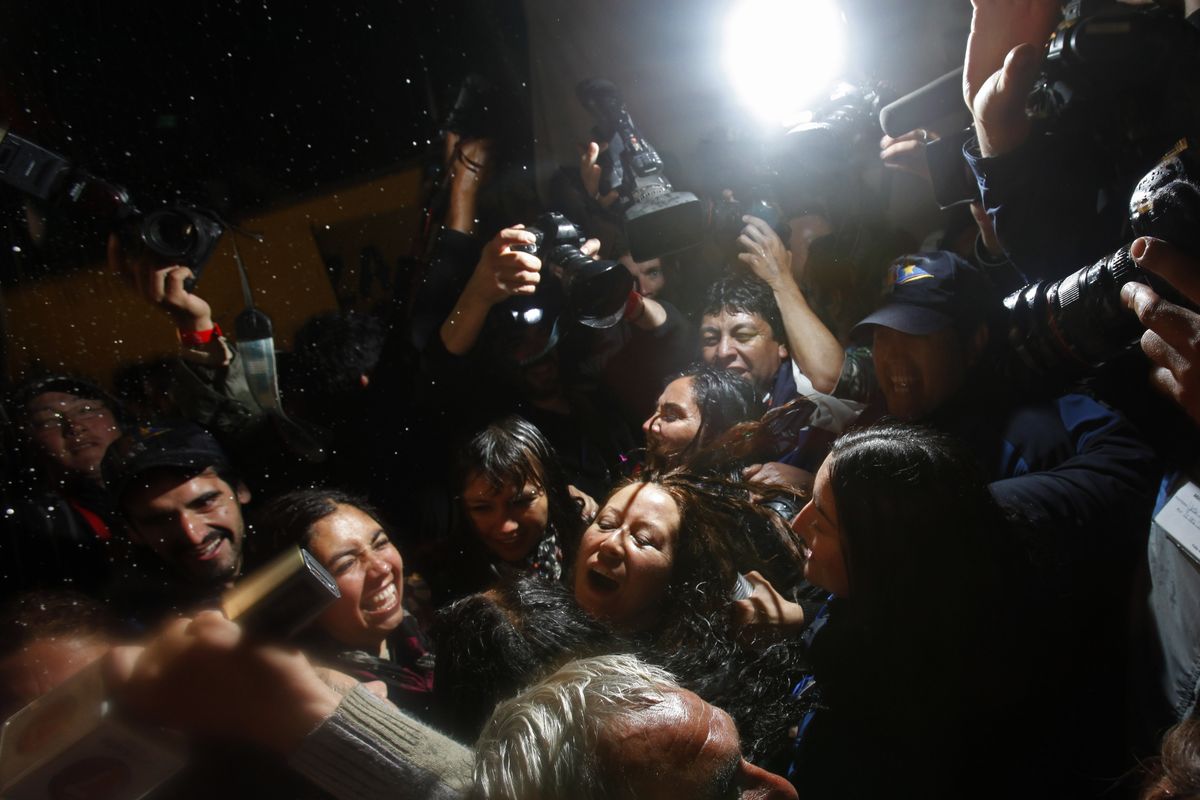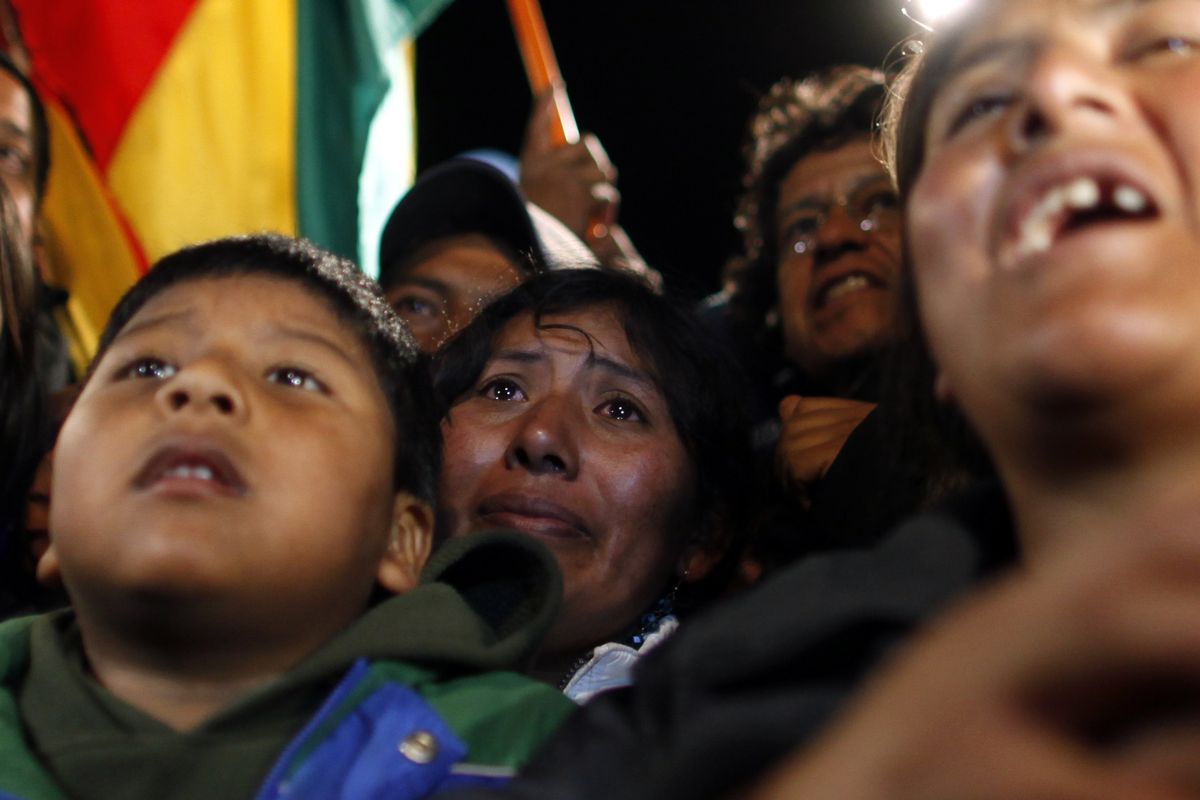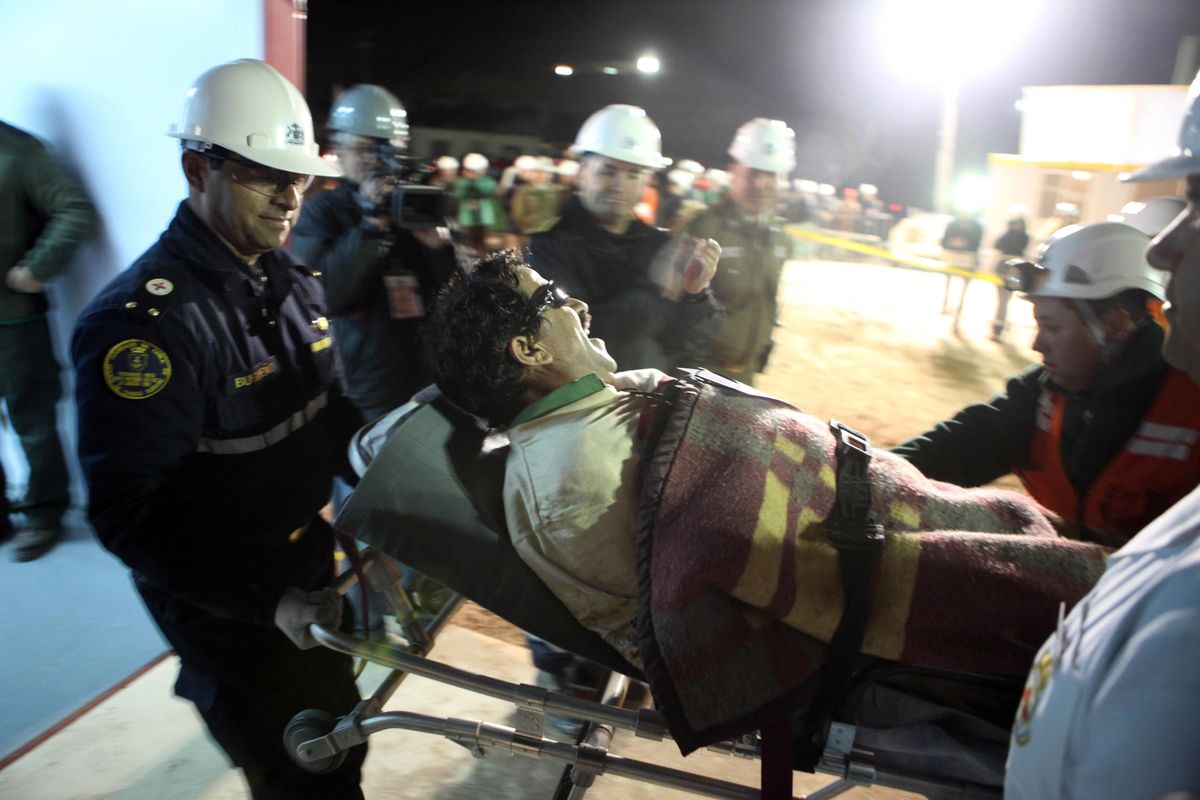All 33 miners reach safety as families, and the world, cheer
Relatives of trapped Bolivian miner Carlos Mamani Solis react while watching his rescue on a TV screen at the camp outside the San Jose mine near Copiapo, Chile, early Wednesday, Oct. 13, 2010. (Natacha Pisarenko / Associated Press)
SAN JOSE MINE, Chile – The longest underground nightmare in history ended safely – and faster than anyone expected.
In a flawless operation that unfolded before a hopeful, transfixed world, 33 miners who were trapped for more than two months deep beneath the Chilean earth were raised one by one Wednesday through a smooth-walled shaft of rock.
The last man out was the one who held the group together when they were feared lost, a shift foreman named Luis Urzua who enforced tight rations of their limited food and supplies before help could arrive.
“We have done what the entire world was waiting for,” he said immediately after his rescue. “We had strength, we had spirit, we wanted to fight, we wanted to fight for our families, and that was the greatest thing.”
Not even a full 24 hours after the rescue began, Urzua made the 2,041-foot ascent in a rescue capsule called Phoenix and emerged from a manhole-size opening in the ground to a joyous celebration of confetti, balloons and champagne.
President Sebastian Pinera told him: “You are not the same, and the country is not the same after this. You were an inspiration. Go hug your wife and your daughter.” With hardhats held to their hearts, the pair led a joyous crowd in singing the national anthem.
The first rescue worker down was last up – Manuel Gonzalez, a mine rescue expert with Chile’s state-owned Codelco copper company, talked the men through the final hours inside the mine. Then, he spent 26 minutes alone down below before he strapped himself into the capsule for the ride up. He reached the surface at 12:32 a.m. today local time to hugs from his comrades and Pinera.
The rescue exceeded expectations every step of the way. Officials first said it might be four months before they could get the men out; it turned out to be 69 days and about 8 hours.
Once the escape tunnel was finished, they estimated it would take 36 to 48 hours to get all the miners to the surface. That got faster as the operation went along, and all the miners were safely above ground in 22 hours, 37 minutes.
The crowd in “Camp Hope,” down a hill from the escape shaft, set off confetti, released balloons and sprayed champagne as Urzua’s capsule surfaced, joining in a rousing miners’ cheer. In the capital of Santiago, hundreds gathered in Plaza Italia, waving flags and chanting victory slogans in the miners’ honor.
In nearby Copiapo, about 3,000 people gathered in the town square, where a huge screen broadcast live footage of the rescue. The exuberant crowd waved Chilean flags of all sizes and blew on red vuvuzelas as cars drove around the plaza honking their horns, their drivers yelling, “Long live Chile!”
“The miners are our heroes,” said teary-eyed Copiapo resident Maria Guzman, 45.
One by one throughout the day, the men had emerged to the cheers of exuberant Chileans and before the eyes of a transfixed world. While the operation picked up speed as the day went on, each miner was greeted with the same boisterous applause from rescuers.
“Welcome to life,” Pinera told Victor Segovia, the 15th miner out. On a day of superlatives, it seemed no overstatement.
They rejoined a world intensely curious about their ordeal, and certain to offer fame and jobs. Previously unimaginable riches awaited men who had risked their lives going into the unstable gold and copper mine for about $1,600 a month.
The miners made the smooth ascent inside the Phoenix capsule – 13 feet tall, barely wider than their shoulders and painted in the white, blue and red of the Chilean flag. It had a door that stuck occasionally, and some wheels had to be replaced, but it worked exactly as planned.
Beginning at midnight Tuesday, and sometimes as quickly as every 25 minutes, the pod was lowered the nearly half-mile to where 700,000 tons of rock collapsed Aug. 5 and entombed the men.
Then, after a quick pep talk from rescue workers who had descended into the mine, a miner would climb in, make the journey upward and emerge from a manhole into blinding light.
The rescue was planned with extreme care. The miners were monitored by video on the way up for any sign of panic. They had oxygen masks, dark glasses to protect their eyes and sweaters for the jarring transition from subterranean swelter to chilly desert air.
As they neared the surface, a camera attached to the top of the capsule showed a brilliant white piercing the darkness not unlike what accident survivors describe when they have near-death experiences.
The miners emerged looking healthier than many had expected and even clean-shaven. Several thrust their fists upward like prizefighters, and Mario Sepulveda, the second to taste freedom, bounded out and led his rescuers in a rousing cheer. Franklin Lobos, who played for the Chilean national soccer team in the 1980s, briefly bounced a ball on his foot and knee.
“We have prayed to San Lorenzo, the patron saint of miners, and to many other saints so that my brothers Florencio and Renan would come out of the mine all right. It is as if they had been born again,” said Priscila Avalos. One of her brothers was the first miner rescued, and the other came out Wednesday evening.
Health Minister Jaime Manalich said some of the miners probably will be able to leave the hospital today – earlier than projected – but many had been unable to sleep, wanted to talk with families and were anxious. One was treated for pneumonia, and two needed dental work.
“They are not ready to have a moment’s rest until the last of their colleagues is out,” he said.
No one in recorded history has survived as long trapped underground. For the first 17 days, no one even knew whether they were alive. In the weeks that followed, the world was captivated by their endurance and unity.
News channels from North America to Europe and the Middle East carried live coverage of the rescue. Pope Benedict XVI said in Spanish that he “continues with hope to entrust to God’s goodness” the fate of the men. Iran’s state English-language Press TV followed events live for a time. Crews from Russia, Japan and North Korean state TV were at the mine.
The images beamed to the world were extraordinary: Grainy footage from the mine chamber showed each man climbing into the capsule, then disappearing upward through an opening.
Among the first rescued was the youngest miner, Jimmy Sanchez, at 19 the father of a months-old baby. Two hours later came the oldest, Mario Gomez, 63, who suffers from a lung disease common to miners and had been on antibiotics inside the mine. He dropped to his knees after he emerged, bowed his head in prayer and clutched the Chilean flag.
Gomez’s wife, Lilianett Ramirez, pulled him up from the ground and embraced him. The couple had talked by video once a week, and she said that he had repeated the promise he made to her in his initial letter from inside the mine: He would marry her properly in a church wedding, followed by the honeymoon they never had.
Read on television by President Sebastian Pinera, Gomez’s “Dear Lila” letter was filled with faith and determination and showed the world the miners were holding strong.
“Even if we have to wait months to communicate … I want to tell everyone that I’m good and we’ll surely come out OK,” Gomez wrote. “Patience and faith. God is great and the help of my God is going to make it possible to leave this mine alive.”



























